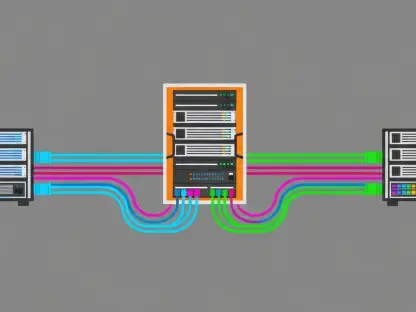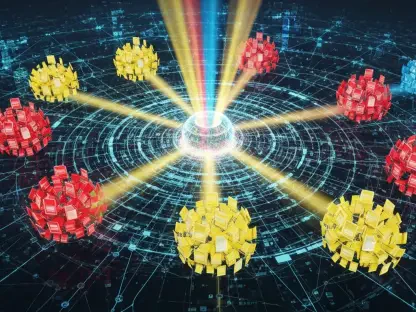In a landscape where open-source solutions often lag behind proprietary counterparts, the Linux community is buzzing with anticipation over a transformative update to the Nouveau driver for NVIDIA hardware in the upcoming Linux 6.19 kernel, promising to bridge long-standing performance gaps. For years, users of Linux systems have struggled with performance disparities when choosing open-source graphics drivers over NVIDIA’s closed-source alternatives. However, this latest development aims to change the narrative by introducing critical enhancements that could redefine expectations. With a focus on memory management optimizations and a renewed spirit of collaboration between NVIDIA and open-source developers, these changes are set to elevate the experience for gamers, AI researchers, and enterprise users alike. The significance of this update extends beyond mere technical tweaks, hinting at a broader evolution in how open-source graphics support is perceived and prioritized within the Linux ecosystem.
Technical Innovations in Nouveau
Memory Management Upgrades
The cornerstone of the advancements in the Nouveau driver lies in a fundamental overhaul of its memory management system, specifically through the adoption of larger memory page sizes. Traditionally limited to 4K pages, Nouveau now supports up to 64K pages, a shift designed to significantly reduce overhead associated with memory mapping. This change decreases the frequency of translation lookaside buffer (TLB) misses, a common bottleneck in high-performance computing tasks. For applications that require rapid access to large amounts of memory—such as modern gaming engines or complex AI model training—this translates to smoother operation and improved throughput. By aligning memory allocation more closely with the capabilities of contemporary NVIDIA GPUs, the driver can handle larger contiguous blocks, paving the way for efficiency gains that were previously out of reach for open-source solutions on Linux systems.
Complementing the shift to larger page sizes is the introduction of compression capabilities within Nouveau’s framework. This feature utilizes hardware-specific functions in NVIDIA GPUs to dynamically compress framebuffers and textures, optimizing memory bandwidth usage. The result is not only a potential increase in frame rates for graphics-intensive applications but also a reduction in power consumption, a crucial factor for mobile and embedded Linux devices. Beyond performance, compression helps manage the ever-growing demands on video memory in modern workloads, ensuring that resources are used more effectively. This dual approach of larger pages and compression marks a significant step forward, addressing longstanding inefficiencies that have hindered Nouveau’s competitiveness against proprietary drivers and setting a new benchmark for what open-source graphics can achieve.
Implementation Challenges
Delving deeper into the technical realm, implementing these memory management upgrades required intricate modifications to Nouveau’s interaction with the kernel’s memory management unit (MMU). The patches, submitted by key maintainers, enable the driver to advertise multiple page sizes to user-space applications, offering greater flexibility in memory allocation. However, this transition is not without challenges, as ensuring compatibility with existing software stacks remains a priority. Discussions on kernel mailing lists reveal a meticulous approach to avoid disrupting current user-space interactions, highlighting the complexity of integrating such advancements into a mature ecosystem. This careful balancing act underscores the dedication to delivering a seamless experience, even as the driver pushes boundaries in performance optimization for NVIDIA hardware on Linux.
Another layer of challenge arises from the need to validate these changes across a diverse array of NVIDIA GPU architectures, spanning from older Fermi designs to the latest Ampere models. While the benefits of larger page sizes and compression are evident in theory, real-world application demands rigorous testing to prevent regressions or unexpected behavior. The focus remains on ensuring that these enhancements do not inadvertently exclude segments of the user base, particularly those relying on legacy hardware. Community-driven testing phases will likely play a pivotal role in identifying edge cases, reinforcing the collaborative ethos that drives open-source development. As these updates progress through the merge window for Linux 6.19, the technical community watches closely, ready to address any obstacles that may arise during integration.
Community and Industry Dynamics
NVIDIA’s Evolving Role
A notable shift in the relationship between NVIDIA and the open-source community underpins the optimism surrounding the Nouveau updates for Linux 6.19. Historically, limited access to NVIDIA’s internal documentation and firmware constrained the development of open-source drivers, leaving projects like Nouveau at a disadvantage. However, NVIDIA’s recent decision to open-source certain GPU modules has injected new energy into these efforts. This move signals a willingness to engage more directly with Linux developers, fostering a sense of cautious enthusiasm across social media platforms like X. While not a complete reversal of past policies, this growing collaboration hints at a future where open-source graphics support could rival proprietary solutions, reshaping perceptions of NVIDIA’s role within the Linux ecosystem.
The impact of NVIDIA’s evolving stance extends beyond technical contributions, influencing how developers and users view the trajectory of open-source graphics. On various online forums, discussions reflect a range of reactions, from cautious hope to outright praise for the company’s newfound openness. This shift is seen as a potential catalyst for further advancements, encouraging other hardware vendors to follow suit in supporting Linux communities. Yet, there remains an undercurrent of skepticism among some stakeholders who recall past challenges, urging vigilance to ensure that this collaboration translates into sustained, meaningful progress. As Nouveau benefits from these dynamics, the broader narrative of corporate and community synergy continues to unfold, with implications for the entire open-source landscape.
Community Feedback
Feedback from the Linux community offers a nuanced perspective on the Nouveau updates, balancing excitement with practical concerns. Many developers and end-users express genuine enthusiasm for the performance gains promised by larger memory pages and compression support, particularly for demanding applications like gaming and AI workloads. Posts on platforms like X highlight a collective anticipation for Linux 6.19 to mark a turning point, potentially narrowing the gap with proprietary NVIDIA drivers. This optimism is fueled by tangible improvements in benchmark expectations for the NVK Vulkan driver within the Mesa project, which stands to gain significantly from these memory optimizations. The community’s response underscores a shared vision of elevating open-source graphics to new heights.
However, alongside the excitement, there exists a thread of caution regarding unresolved challenges that could temper the impact of these updates. Compatibility with older NVIDIA hardware remains a concern, as not all GPUs may fully support compression or larger page sizes without extensive adaptation. Additionally, the community emphasizes the importance of comprehensive testing across varied architectures to prevent unforeseen issues after release. Voices on social media and developer forums advocate for thorough validation, reflecting a mature understanding that while the potential is immense, execution is key. This balanced feedback illustrates a community deeply invested in the success of Nouveau, ready to contribute insights and efforts to ensure that the advancements in Linux 6.19 deliver on their promise.
Ecosystem Impact and Future Directions
Beyond Gaming Applications
The enhancements to Nouveau in Linux 6.19 extend far beyond the realm of gaming, offering substantial benefits for enterprise environments and AI-driven workloads. Virtualized systems, often burdened by memory inefficiencies, stand to gain from the driver’s improved handling of larger page sizes, which can streamline resource allocation in hypervisors. Similarly, AI computations that rely on vast memory pools for model training could see performance improvements, making Linux a more compelling platform for data scientists. Moreover, the potential integration with other kernel contributions, such as Microsoft’s RAMDAX driver, points to a collaborative push to strengthen Linux’s capabilities in data centers. These developments signal a maturing ecosystem where open-source graphics support aligns with the needs of diverse, high-stakes applications.
Another critical aspect is the impact on power efficiency, a growing concern in enterprise and mobile Linux deployments. The compression capabilities introduced in Nouveau not only optimize memory usage but also reduce bandwidth demands, leading to lower energy consumption. This is particularly relevant for embedded systems and laptops, where battery life is a priority. As organizations increasingly adopt Linux for scalable, cost-effective solutions, these updates could influence adoption rates, positioning the platform as a viable alternative for workloads traditionally dominated by proprietary systems. The broader implications suggest that Linux 6.19 may catalyze a shift in how industries perceive open-source graphics, opening doors to innovative use cases and deployments.
Comparison with Nova Driver
Contrasting Nouveau’s current advancements with NVIDIA’s experimental Nova driver provides insight into the evolving landscape of open-source graphics support. While Nouveau offers practical, immediate improvements through memory management upgrades in Linux 6.19, Nova represents a forward-looking initiative, built from the ground up in Rust for modern kernel integration. The differences in approach highlight a dual strategy: Nouveau addresses existing user needs with proven technology, whereas Nova experiments with cutting-edge paradigms that could redefine standards in the future. This juxtaposition underscores the dynamic nature of open-source development, where incremental progress coexists with visionary experimentation, ultimately benefiting the Linux community.
The interplay between these two projects also suggests a potential convergence in design philosophies over time. Lessons learned from Nouveau’s implementation of larger page sizes and compression could inform Nova’s development, ensuring consistency across NVIDIA’s open-source offerings. Community discussions on platforms like X reflect an appreciation for this complementary dynamic, with some users viewing Nouveau as the reliable choice for now, while keeping an eye on Nova’s long-term potential. As both drivers evolve, their combined impact could shape a robust framework for graphics support on Linux, challenging the dominance of proprietary solutions. Looking back, the strides made with Linux 6.19 stand as a testament to the power of community-driven innovation.
Reflecting on a Milestone
Reflecting on the journey, the integration of larger memory pages and compression in Nouveau for Linux 6.19 proved to be a defining moment for open-source NVIDIA graphics support. These updates addressed longstanding performance disparities, bringing tangible improvements to diverse applications while highlighting the strength of collaboration between NVIDIA and the Linux community. As the ecosystem absorbed these advancements, attention turned to the next steps—ensuring compatibility, expanding testing, and building on this foundation for future kernel releases. The focus shifted toward fostering adoption in major distributions and encouraging developers to explore new possibilities in gaming, AI, and enterprise solutions. This milestone laid a strong groundwork, inviting stakeholders to push boundaries further and solidify Linux as a powerhouse for graphics-intensive computing.









